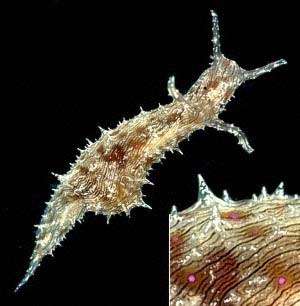
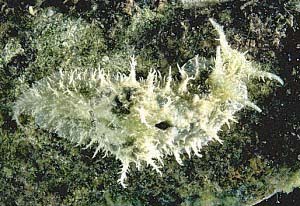
Stylocheilus striatus
(Quoy & Gaimard, 1832)
Order: ANASPIDEA
Superfamily: APLYSIOIDEA
Family: Aplysiidae
DISTRIBUTION
Circum-tropical (Indo-West Pacific & Atlantic).
PHOTO
UPPER: Koumac, New Caledonia, October 1993, 15m, outside of reef, on coral slabs, 15mm long alive. Inset: showing eyespots and longitudinal lines.
LOWER: Coffs Harbour Region, northern New South Wales, intertidal, December 1990. Length: 50mm.
PHOTOS: Bill Rudman.
This relatively small elongate Sea Hare usually has dark longitudinal lines and scattered eye spots, either with pink or blue centres. Although usually smaller, animals I collected in Zanzibar (1976) grew to 6.5cm in length. Like many Sea Hares they produce a purple ink when disturbed.
Like Bursatella leachii, this species feeds on blue-green algae which form a mat or film over rocks or the surface of muddy shores. Found from the intertidal to about 30m, Stylocheilus striatus can sometimes be found in large numbers. (See Cory Pittman's message for a description of aggregations of Stylocheilus in Hawaii.
I have listed some references on various aspects of the biology, physiology and natural history of Stylocheilus separately.
NOMENCLATURAL NOTE: This species has usually been identified as Stylocheilus longicauda (Quoy & Gaimard, 1825). See my message and the separate page where the correct identity of that species is discussed. (5 August 1999)
Reference:
• Quoy, J.R. & Gaimard, J.P. (1832). Voyage de decouvertes de L'Astrolabe pendant les annees 1826-1827-1828-1829, sous le commandement de M.J. Dumont D'Urville, Zoologie, 2: 1-686.
Rudman, W.B., 1999 (August 5) Stylocheilus striatus (Quoy & Gaimard, 1832). [In] Sea Slug Forum. Australian Museum, Sydney. Available from http://www.seaslugforum.net/find/stylstri
Related messages
Sea hare from Isla Marada, Florida
April 8, 2010
From: W. Robert Hudgins
From a dock on the Atlantic side of Isla Marada Key, Florida, I observed a sea Hare that was 35 cm long and brown-shoe brown. It had bright round orange spots surrounded by a black border that gave a bull's-eye effect. It lengthened and shortened and at full extension, it may have been more than 35 cm. When its "ears" were extended the "hare" appearance was dramatic. From my perspective the gills were small and not well defined. Water depth was about 45 cm and very calm. It crawled over brown algae masses about 20cm tall, moving about 40 m in 24 hr.
Locality: Isla Marada, 0.5m, Florida, USA, Sand behind reef, March 2010, Sand/carbonate-mud. Length: 35 cm
W. Robert Hudgins
hudginswr@msn.com
Hudgins, W.R., 2010 (Apr 8) Sea hare from Isla Marada, Florida. [Message in] Sea Slug Forum. Australian Museum, Sydney. Available from http://www.seaslugforum.net/find/23433Dear Bob,
Form your description of 'eye spots' my first thought is the sea hare, Stylocheilus striatus [see message #16120 about an animal from Brazil with blue spots and orange spots], but at 35 cm, your animal is much larger than any Stylocheilus I have seen. The two common sea hares in yoru part of the world are Aplysia morio and A. brasiliana but I don't know of any record of them having eye spots. If you animal was 35 mm it would fit in the Stylocheilus range?
Best wishes,
Bill Rudman
Aggregation of Stylocheilus in the Philippines
July 21, 2008
From: Marcel Tanke
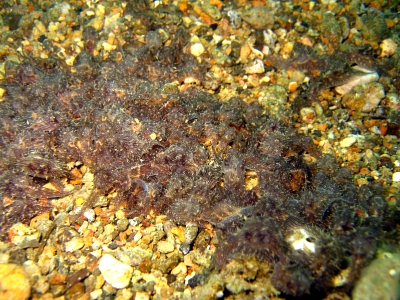
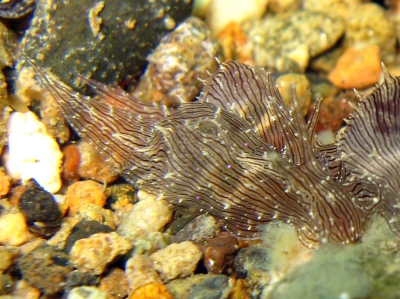
Dear Bill,
On the Anilao sandy bottom dive site near Malnit (site is also called Secret Bay), we saw 4 or 5 mass aggregations of these nudibranchs. The aggregations were no more than 2 meters from each other and consisted of about 100 (?) individuals each. I checked if there was any food below one aggregation. Just a slight 'waving' of the hand (or a kick of the fin) easily disperses the whole group. I did not see anything special below them. Just sand / pebbles. Although, in the whole area the sand is covered with some algae. The movement of the nudibranchs was relatively fast, crawling over- and on top of each other.
Locality: Anilao, 3 meter, Philippines, 12 July 2008, Sandy bottom. Length: 3 cm. Photographer: Marcel Tanke.
I have not been able to ID this nudibranch. Would you know it?
Any suggestion for this behaviour?
Best regards,
Marcel
marceltanke@cs.com
Tanke, M.A., 2008 (Jul 21) Aggregation of Stylocheilus in the Philippines. [Message in] Sea Slug Forum. Australian Museum, Sydney. Available from http://www.seaslugforum.net/find/21722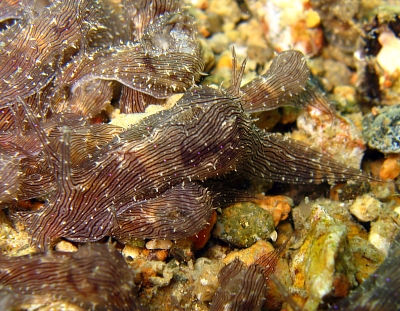
Dear Marcel,
The animals are the small Sea Hare Stylocheilus striatus. If you go to the species Fact Sheet you will find quite a few messages recording these swarming events in many parts of the world. Also have a look at the Mass Mortality Fact Sheet for more discussion on this phenomenon in Stylocheilus and other Sea Hares.
Best wishes,
Bill Rudman
Re: Line of slugs and aggregations
November 24, 2007
From: Jean-François Hervé
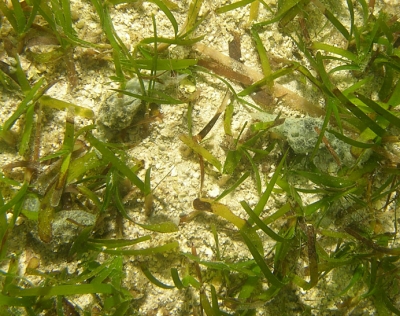
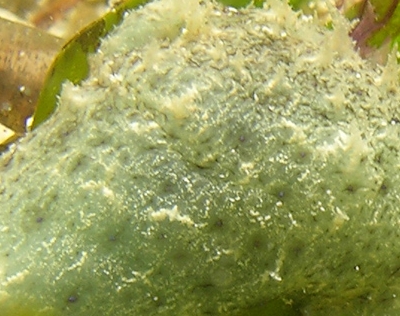
Concerning message #21008:
Dear Bill and everyone,
I was in Poe Beach last week end and I saw the aplysid aggregations. There were 5 to 8 by m2 on a long distance. Probably it's Stylocheilus striatus but I don't see stripes. It was not easy to take picture with the waves and sun but I send you 3 of them. We could see purple ink in the back of a stressed animal.
Locality: Poe Beach, Bourail, 1 m, New Caledonia, Pacific Ocean, 11 November 2007, Sand and algae. Length: 5 cm. Photographer: Jean-François Hervé.
Thank you for your help.
Jean-François Hervé
http://jfherve.free.fr/nudibranches/
jfherve@free.fr
Hervé, J.-F., 2007 (Nov 24) Re: Line of slugs and aggregations. [Message in] Sea Slug Forum. Australian Museum, Sydney. Available from http://www.seaslugforum.net/find/21124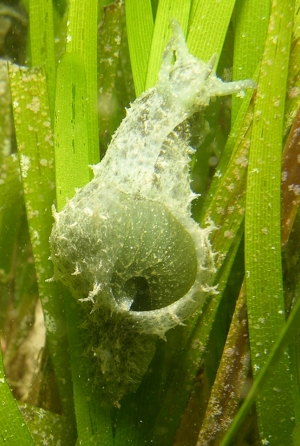
Dear Jean-François,
It's always a bit of a nuisance when a species doesn't have the character which give the species its name, but the dark 'striae' or lines are not always found in Stylocheilus striatus. Your photo alongside gives us a good view of the gill in the cavity formed by the parapodia. Have a look at my drawing in an earlier message [#7872] to get some idea of the parts.
Best wishes,
Bill Rudman
Line of slugs and aggregations
November 5, 2007
From: Kim Friedman
Dear Bill
On the west coast of New Caledonia in 1m of water I saw a line of approx 6 cm long slugs crawling along the sand and aggregating, in there 1000's, on coral bommies.
Locality: Poe Beach , 1m, New Caledonia, Pacific, 21 October 2007, clean sand. Length: 6cm. Photographer: none - sorry.
They looked like aplysids, and were light greenish brown with a rough skin.
Any help on an ID please?
Thanks
Kim
kimf@spc.int
Friedman, K., 2007 (Nov 5) Line of slugs and aggregations. [Message in] Sea Slug Forum. Australian Museum, Sydney. Available from http://www.seaslugforum.net/find/21008Dear Kim,
The animals are almost certainly the little sea hare Stylocheilus striatus. If you go to the species Fact Sheet you will find quite a few messages recording these swarming events [see #15378 for example] in many parts of the world. Also have a look at the Mass Mortality Fact Sheet for more discussion on this phenomenon in Stylocheilus and other Sea Hares.
Best wishes,
Bill Rudman
Stylocheilus swarming in Cuba
September 6, 2007
From: Alfredo Barroso
Hi,
I put in www.youtube.com a short (and not serious at all) video called "Stylocheilus". There you see a gathering of those seahares and other behavior. Does someone knows if these gatherings are for feeding, or is it for reproduction? Is it some kind of defensive behavior? And why do they bury themselves under the sand in the end? Is it to wait for new algae to grow and then go back feeding on them? What kind of algae do they feed upon? Do they do these gatherings only in the sand?
Locality: Trinidad , 12 mts (40 ft), Cuba, Caribbean, August 2004, Sand. Photographer: Alfredo Barroso.
Thank you very much!
Alfredo Barroso
azuloceano@yahoo.com
Barroso, A., 2007 (Sep 6) Stylocheilus swarming in Cuba. [Message in] Sea Slug Forum. Australian Museum, Sydney. Available from http://www.seaslugforum.net/find/20651Dear Alfredo,
If you go to the Stylocheilus striatus Fact Sheet and look at the attached messages you will see a lot of examples and discussion on why they swarm like this. Also have a look at the Mass Mortality Fact Sheet for more discussion on this phenomenon in Stylocheilus and other Sea Hares.
Best wishes,
Bill Rudman
Re: Meeting of the Sea Hares
March 26, 2007
From: Ann Clear
Concerning message #19743:
Hi Bill,
Thank you for your quick reply, indeed it was a spectacular sight. The algae that they were eating was a grey/ green colour, which is the green hue seen in the photo around the sea hares. We were diving with one of your other fans Danny Van Belle, who is a professional video photographer and he took a lot of video footage of the sea hares.
Best regards
Ann
ann.clear@btinternet.com
Clear, A., 2007 (Mar 26) Re: Meeting of the Sea Hares. [Message in] Sea Slug Forum. Australian Museum, Sydney. Available from http://www.seaslugforum.net/find/19748Dear Ann,
Thanks for the clarification. Yes that is the layer they normally eat. I misinterpreted what you meant by 'clump' of algae.
Best wishes,
Bill Rudman
Meeting of the Sea Hares
March 23, 2007
From: Ann Clear
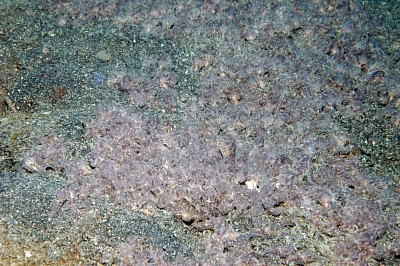
Hi Bill,
Having been an avid daily reader of the forum, I would just like to share with you that having just returned from a dive trip in the Lembeh Straits, I was honoured to see lots and lots of sea hares eating a large clump of algae on the sandy bottom. I immediately recognised what they were, from having read about them on the forum and was amazed to actually see them in real life.
Locality: Tangorosa Dive site Lembeh Straits, 14 meters, Lembeh Straits Indonesia, Indo Pacific, 4th March 2007, muck dive sandy bottom. Length: 1 inch each. Photographer: Ann Clear.
Just thought I would share this info with you.
Regards Ann Clear
ann.clear@btinternet.com
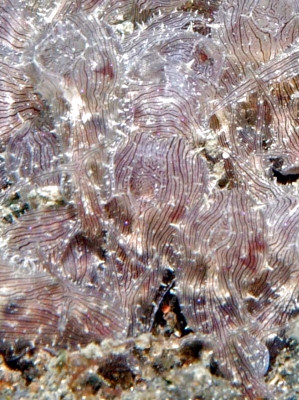
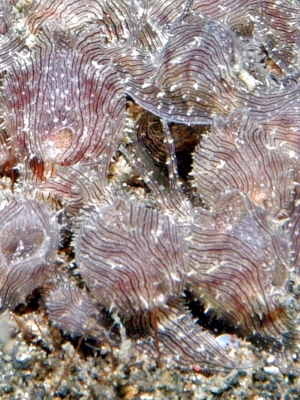

Dear Ann,
It is certainly a spectacular sight seeing these seething masses ofStylocheilus striatus . Thanks so much for sharing the record with us. Contributors to the Forum are turning what was thought to be quite rare occurrence, into a fairly normal part of this species' life cycle. You mention that you saw them eating a large clump of algae. They usually feed on a brown 'skin' of what we used to call blue-green algae but is more properly identified as cyanobacteria, so I would be interested in any information you have on the algae. The only possible algae I can see in your photos are the thin red-brown filaments in the photo alongside.
Best wishes,
Bill Rudman
Re: Swarming of Stylocheilus striatus
February 22, 2007
From: Everett M.Turner Jr.
Concerning message #19488:
Hi Bill,
Thanks for the reply and the information. The more I learn about these creatures the more fascinating they become. I understand why the sea slug forum has become so popular.
Everett
everett@dollyjebenterprises.com
Turner, E.M., 2007 (Feb 22) Re: Swarming of Stylocheilus striatus. [Message in] Sea Slug Forum. Australian Museum, Sydney. Available from http://www.seaslugforum.net/find/19505Swarming of Stylocheilus striatus
February 21, 2007
From: Everett M.Turner Jr.

Hi,
In April of 2006, my wife and I were diving in Carlisle Bay in Barbados. We were at a depth of about 25-30 feet when we notice what we thought was a carpet of algae on the sandy bottom. Closer inspection revealed this "carpet" to be very tiny sea hares. This carpet of sea hares was about 3 feet wide and extended in a wandering fashion over the bottom at depths of 50-60 feet to the 25-30 feet where we first noticed. We followed it for perhaps 50 yards and it extended as far as we could see in both directions over the sandy bottom.
We had never seen this before and took some pictures (not very good pictures. I posted them on my web site, www.dollyjebenterpises.com, on the "other" page and asked if anyone knew what they were. I was contacted by Les Wilk of Reef Net who advised they were Stylocheilus striatus and they were swarming. He directed me to your site, hence this message.
Locality: Carlisle Bay, Between 25-50 feet, Barbados, Caribbean, 27/28 April 2006, sandy/ patch reef. Length: 1/4-3/4 inches. Photographer: Everett Turner.
The pictures I took are still on my site and can be viewed at www.dollyjebenterprises.com on the "Other items " page.
Dr. Everett M. Turner Jr.
everett@dollyjebenterprises.com
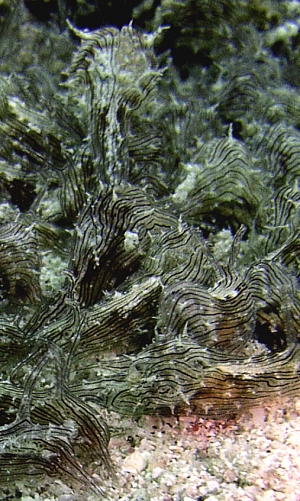
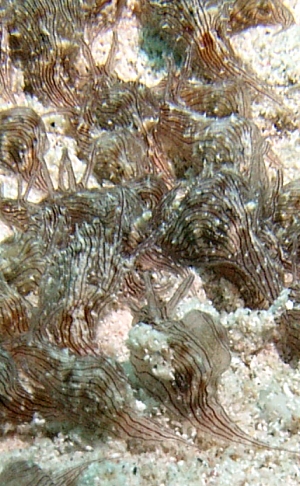
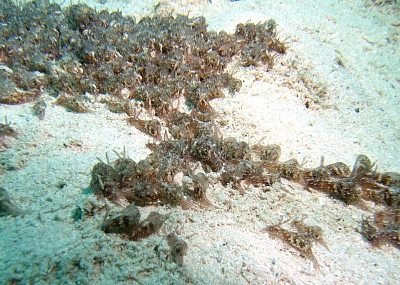
Dear Everett,
These 'swarmings' are certainly spectacular events. In your upper photo I suspect the darker colour on the sand, at the bottom left, is the brownish layer of blue-green algae [or more properly cyanobacteria] on which these small sea hares feed. I suspect the sand is whiter near the animals because they have eaten the organic layer. No doubt you have seen the mass mortality page where these events are discussed and listed.
In the large photos you sent I noticed quite a few little pinkish purple stains in the water, one of which you can see at the bottom of the middle left photo. This is the purple ink which many sea hares squirt out when they are disturbed.
Thanks for sending us these photos
Best wishes,
Bill Rudman
Stylocheilus striatus from Brazil
March 22, 2006
From: Fabio Amorim
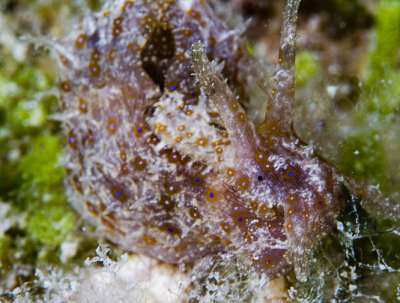
Hi,
I found this while did a dive in the south of Bahia (Brazil) last week. Based on my weak knowledge about slugs I couildn't find which family it belongs to.
Locality: Abrolhos, 5m, Bahia, Brazil, Atlantic Ocean, 3 March 2006. Length: 25mm. Photographer: Fabio Amorim.
Thanks
Fabio
amorim.fabio@gmail.com
Amorim, F.L., 2006 (Mar 22) Stylocheilus striatus from Brazil. [Message in] Sea Slug Forum. Australian Museum, Sydney. Available from http://www.seaslugforum.net/find/16120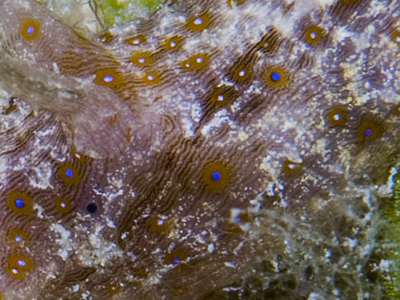
Dear Fabio,
This is a sea hare named Stylocheilus striatus. The dark lines on the body and the blue spots are good characters of this species.
Best wishes,
Bill Rudman
Stylocheilus striatus from Western Australia
March 13, 2006
From: Karen Stackpole
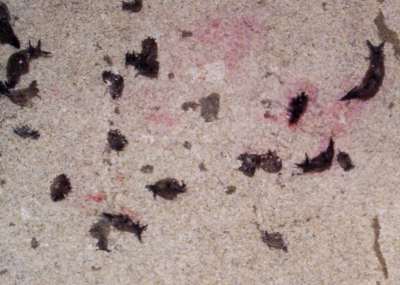
These pictures were taken about January 23rd 2006 at a beach in Bussleton, Western Australia.The temperature on the day would have been in the mid thirtys. The water was relatively calm and was almost clean of sea weed. These creatures were in huge abundance in the water of a swimming beach and looked like pieces of brown seaweed. They were washing up on the beach in their hundreds. My son collected many live ones and put them in a water pool that he had created in the sand. They were aproximately 1 - 2 inches in length, brown in colour and had a tenticle looking surface on their skin. When placed in the water pool many of them released a reddish/purple 'gel' substance from a slit in their back which floated temporarily before soaking into the sand. They moved about the space using movements similar to a catapillar or slug. I have been looking at various sights to try and find out what they were. Can you help indentify them.
Locality: Bussleton - Meelup Beach, Western Australia, 23 January 2006, Washing up onto swhite sandy beach. Length: 1 - 2 inches. Photographer: Karen Stackpole.
Karen Stackpole
kelja@bmail.com.au
Stackpole, K, 2006 (Mar 13) Stylocheilus striatus from Western Australia. [Message in] Sea Slug Forum. Australian Museum, Sydney. Available from http://www.seaslugforum.net/find/16097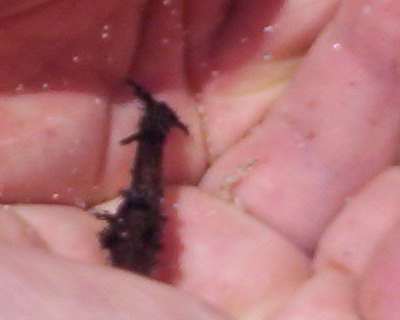
Dear Karen,
These are Sea Hares and most of them produce a reddish purple ink when disturbed. Your animal is almost definitely Stylocheilus striatus which you'll see from earlier messages is often found in large numbers like this.
For more information on Sea Hares look at the General Topics Index {see navigation bar at top left of page]
Best wishes,
Bill Rudman
Re: 1000s of Sea Hares in Hawaii
November 30, 2005
From: Chris Porter
I was looking for information on sea hare behavior I witnessed in Hawaii (Kahala Beach, Oahu) in the early-mid 1990s and came across this site [see message #14074]. I was snorkeling, and noticed long bands of sea hares (the brown splotchy common kind, perhaps Aplysia...) traveling in the same direction, head to tail, so to speak. After I noticed the first few lines of sea hares creeping through the algae and sand, and all appeared to be heading in the same general direction, I decided to see if I could find out where they were all 'heading' to. I followed the lines till I came upon a large disk of sea hares, about 5-6 feet in diameter, of just thousands of sea hares making a slowly rotating disk of sea hares in the sand, with the straggling lines of sea hares adding to the disk accreation along the edges. Thousands in the disk, and more coming up to the disk in long lines, and adding to it.
There doesn't seem to be much I can find on the internet about this behavior, so I thought I'd submit this observation.
Locality: Kahala Beach, Oahu, Hawaii, USA. Pacific. Depth: 3-5 feet. Length: thousands, I would guess about 1.5-2 inches or so. Fall, sometime between 1992-95. sandy flat, coraline algae, right up to shore, about 20-30 feet away from shore
Chris Porter
chrisporter9@wi.rr.com
Porter, C., 2005 (Nov 30) Re: 1000s of Sea Hares in Hawaii. [Message in] Sea Slug Forum. Australian Museum, Sydney. Available from http://www.seaslugforum.net/find/15386Dear Chris,
Thanks for the observation. I suspect your animal was the sea hare Stylocheilus striatus. As you have note, we have quite a few records of this species, doing much as you describe, from Hawaii, and many other parts of the world. In fact all the messages about this species since June concern swarming.
Best wishes,
Bill Rudman
Aggregation of Stylocheilus striatus in Indonesia
November 29, 2005
From: Paul Whitehead
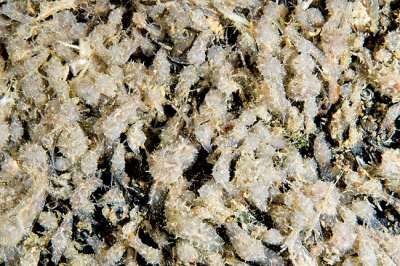
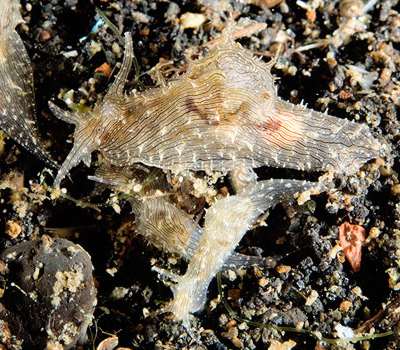
Dear Bill,
Attached are some photographs of a large aggregation of seahares [Stylocheilus striatus] at Lembeh Straits. The scene was observed after the full moon and was replaced by aggregations of two species of nudibranchs over the following week (i.e. 3 different species aggregrations all on the same site within the space of a week). I am still waiting for the photographs of the other two species but will post them as soon as I get them. [see messages: #15629, #15630 ]
Locality: Retak larry, Indonesia. Lembeh Straits. Depth: 3 meters. Length: Up to 30 mm. 12 September 2005. black dand beach with sparse cover. Photographer: Paul Whitehead
The site was Retak Larry, a shallow black sand site of between 3 and 4 meters depth
Paul Whitehead
info@envirosea.com
Whitehead, P., 2005 (Nov 29) Aggregation of Stylocheilus striatus in Indonesia. [Message in] Sea Slug Forum. Australian Museum, Sydney. Available from http://www.seaslugforum.net/find/15378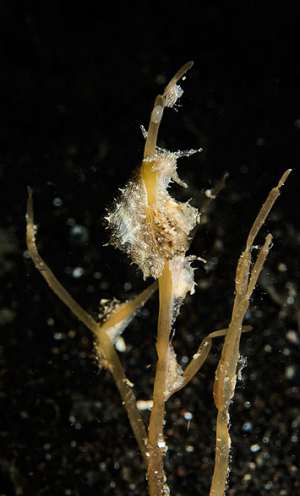
Dear Paul,
This is certainly a worldwide behaviour for this species. I look forward to seeing what the other 2 species are that you found 'swarming' like this
Best wishes,
Bill Rudman
Swarming of Stylocheilus striatus at Bonaire
November 7, 2005
From: Les Wilk
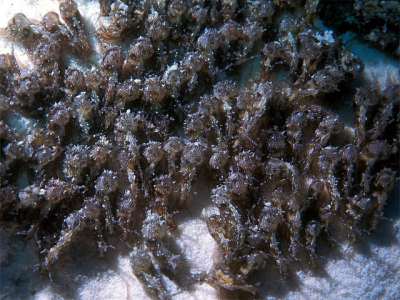
Dear Bill,
In response to the swarming Stylocheilus messages [#15175 ], I didn't know there was such a thing as "swarming sea hares" until we witnessed such an event in April 2004 on the Caribbean island of Bonaire. There were several huge aggregations a few meters apart, joined by narrow trails of marching hares. A couple of days later they were gone.
Locality: Tori's Reef, Bonaire. Caribbean Sea. Depth: 25 feet. 09 April 2004. sandy bottom. Photographer: Les Wilk
Les Wilk.
wilk@reefnet.ca
Wilk, L., 2005 (Nov 7) Swarming of Stylocheilus striatus at Bonaire. [Message in] Sea Slug Forum. Australian Museum, Sydney. Available from http://www.seaslugforum.net/find/15182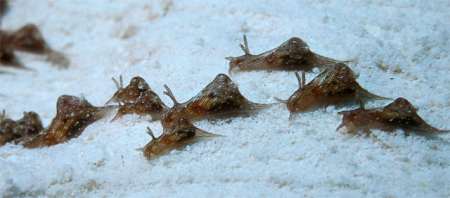
Dear Les,
I don't think anyone in the world knew just how widespread this phenomenon is in Stylocheilus, until reports started appearing on the Forum. Some of my colleagues don't think the Forum is 'science' but it looks like the creation of new knowledge to me.
April is certainly a bit earlier in the year than the June/July reports we have had before from the Caribbean for Stylocheilus swarming, which again demonstrates just how little we know.
Best wishes,
Bill Rudman
Reunion Is - Swarming and spawning of Stylocheilus
November 5, 2005
From: Philibert Bidgrain
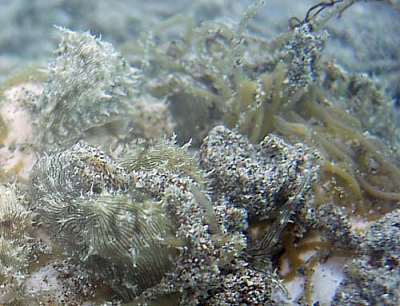
Dear Bill,
Reunion Island sea slugs.
Three days after the first sighting of the swarm behaviour of Styocheilus striatus [message #15142], I found along the shore in 30 to 80 cm of water, groups of about hundred specimens who were spawning small egg strings on dead coral or little rock scattered on the sandy substrate.
Locality: Trou d'eau Llagoon. Reunion Island, Indian Ocean. Depth: 80 cm. 29 october 2005. Photographer: Philibert Bidgrain
I put in my aquarium a little fragment of dead coral covered with Stylocheilus spawn. Four days later, the eggs have disappeared, and I observed floating on the surface, small veliger larvae. In the same lagoon we observed on October 20 a massive coral spawning. "It's the spawning month..."
Best Regards
Philibert Bidgrain
http://vieoceane.free.fr/runseaslug/indexslug.htm
pbidgrain@yahoo.fr

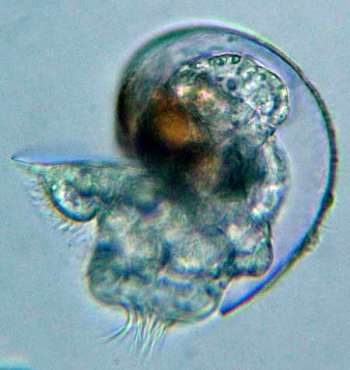
Dear Philibert,
Thanks for bringing spawning into the picture. It is also coral spawning time (Oct-Nov) on the Great Barrier Reef, which fits Nerida's recent message [#15162] of Stylocheilus swarming there, But before we jump to conclusions, coral spawning in the Caribbean is also Sept- Oct which doesn't fit with Stylocheilus swarming, and from what I gather, coral spawning in Hawaii is a long drawn out affair from April to September.
Best wishes,
Bill Rudman
Re: Stylocheilus striatus swarms at Reunion Island
November 3, 2005
From: Nerida Wilson
Hi Bill,
In response to the recent mesage from Reunion Island [#15142] I thought it would be interesting that Stylocheilus striatus are currently also swarming at Lizard Isand, Great Barrier Reef. The first sighting was of a developed swarm about the 26th October. I was sent photographs of this a few days ago. It is interesting that it appears synchronous in two different oceans....
cheers
Nerida
wilsong@auburn.edu
Wilson, N.G., 2005 (Nov 3) Re: Stylocheilus striatus swarms at Reunion Island. [Message in] Sea Slug Forum. Australian Museum, Sydney. Available from http://www.seaslugforum.net/find/15162Thanks Nerida,
I don't know what it all means, as the last reports we had in June/July were from Hawaii and the Caribbean
Best wishes,
Bill Rudman
Stylocheilus striatus swarms at Reunion Island
October 31, 2005
From: Philibert Bidgrain
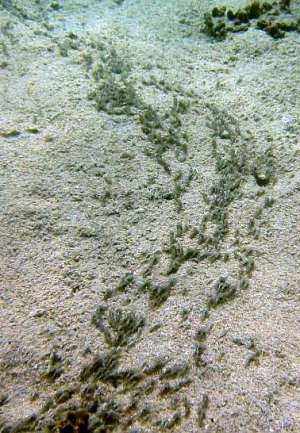
Dear Bill,
Re Reunion Island sea slugs.
A few days ago Daniel Nardin reported seeing many groups of hundreds, and in some cases more than one thousand Stylocheilus striatus in "Trou d'eau" lagoon crawling on the sandy substrate. It's the first time than we have observed this gregarious behavior. Is it usual for them to do this? What's the reason of this abnormal number, and this gregarious behavior?
Locality: "Trou d'Eau" Lagoon, Reunion Island. Indian Ocean. Depth: 50 cm
Length: 4 cm. 28 October 2005. sandy substrate. Photographer: Daniel Nardin
Best Regards
Philibert Bidgrain
http://vieoceane.free.fr/runseaslug/indexslug.htm
vieoceane@free.fr
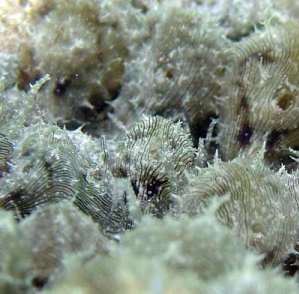
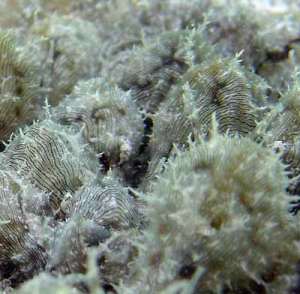
Dear Philibert,
If you have a look at the "Related Messages" listed below your message, for June and July 2005, you will see similar reports of Stylocheilus swarming from the Caribbean and Hawaii, and links to other discussions on the Forum about this phenomenon. It is a spectacular sight.
Best wishes,
Bill Rudman
Stylocheilus striatus from Wollongong, New South Wales
September 14, 2005
From: Sascha Schulz
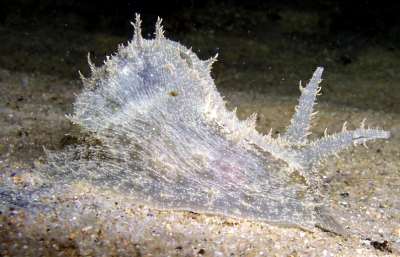
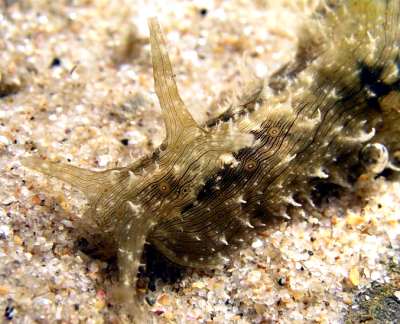
Dear Bill,
I found hundreds of these in a rockpool at Wollongong, NSW, eastern Australia in May 2005 Ranging from 50 to 150 mm long. I have no idea what they are. Are the two colours the same species?
Sascha Schulz
ss31@dodo.com.au
Schulz, S., 2005 (Sep 14) Stylocheilus striatus from Wollongong, New South Wales. [Message in] Sea Slug Forum. Australian Museum, Sydney. Available from http://www.seaslugforum.net/find/14759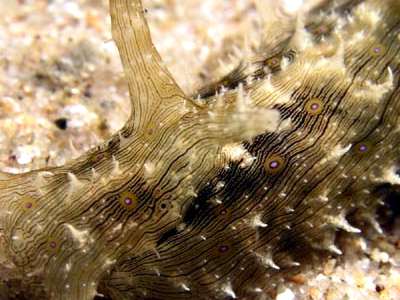
Dear Sascha,
This is the small sea hare Stylocheilus striatus, which you'll see from other messages, is quite often found in large numbers. I have included a close-up alongside to show the distinctive colour poattern of lines and coloured 'eye-spots'.
Best wishes,
Bill Rudman
Stylocheilus striatus swarming - Turks & Caicos Ids
July 29, 2005
From: Martin Banford
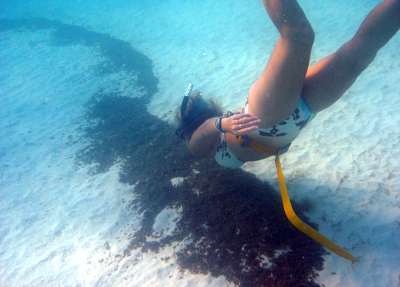
A friend of mine who runs a windsurfing school on the island phoned me last month to come check out something going on by his area of the beach. Some of the people swimming from the beach had found all these little things floating in the water and wondered what they were. They look very much like blue-ring sea hares to me, but I am just wondering if you have ever known them to congregate in this number. Usually when someone says there were millions, they are exaggerating, but if they had not managed to make up a million, they were not far off. There were large areas of dispersed ones, and then two long lines almost like battle fronts of these things, moving steadily eastward. My friend Lyn who is a dive instructor here is in the first pic to give some idea of the scale of the number of these things. I swam the length of this particular line shooting video. I had fins on so I was not hanging around, but the clip taken swimming from one end of the line to the other is 30 seconds long. One suggestion made was that they may have been newly hatched. They were very close in to the shore - some were even sloshing around in the shore break, but the main body of them were about 3 to 15m out from the edge of the water. I would be interested to hear your comments and suggestions as to what may have brought this about.
Locality: Grace Bay, Provo, Turks & Caicos Islands, Tropical West Atlantic. Depth: 0.5 - 3 m. Length: 3-4 cm. 17th June 2005. Sandy bottom. Photographer: Martin Banford
Thanks very much.
Martin Banford
caicosbeachbum@hotmail.com
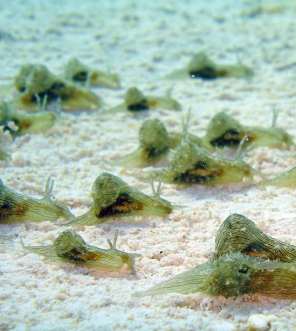
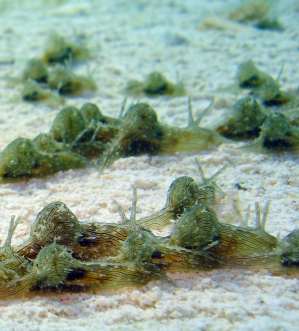
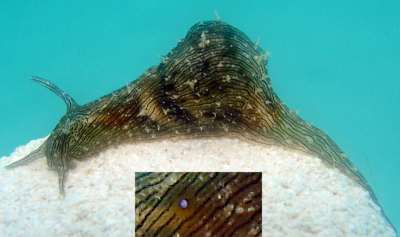
Dear Martin,
We have had a number of recent reports of this swarming behaviour in Stylocheilus striatus from both the Caribbean and Hawaii. If you have a look at my comments in Jim Chambers message [#14080] from the Cayman Ids, the links will lead you to further information on this spectacular occurrence.
As you will read, there is some debate about what is happening, but my feeling is that these swarms of sea hares, which are usually of adult animals - at the size you give, your animals are definitely adults - which for some reason are weakened, or have reached the end of their life span, and are dying. I suspected they haven't 'migrated' together, but have grown up together and are only noticeable at an adult size. Perhaps they have eaten out their food supply? It is true that they all seem to be marching in the same direction, but opisthobranchs usually follow the mucous trail of their own kind, so if they have all aggregated together it is quite natural they are following each other's trail, but it doesn't necessary follow that they are 'migrating' to a particular place. Your description of some of them sloshing around near the tide line adds weight to the idea they are weakened and near death.
It would be a great thing from someone to study, but many of these phenomenon are over so quickly, and occur so irregularly at any one place, that planning a research project on them would be very difficult
Best wishes,
Bill Rudman
Swarming Sea Hares in Hawaii
July 8, 2005
From: Jim Spears
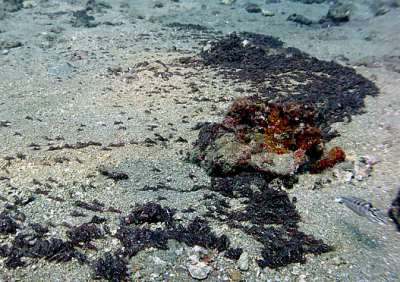
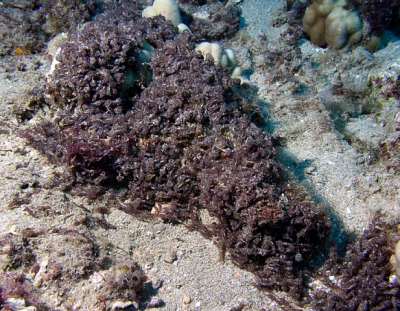
Aloha,
I am a dive friend of Mike Roberts [message #14074 ] and have also witnessed the swarms of Lined Sea Hares, both on the ocean floor and in the water column.
Locality: Makena, Maui, Hawaii, USA. Depth: 60 feet. Length: approx. 1inch. 06 July 2005. sand area surrounding a small military wreck. Photographer: Jim Spears
Jim Spears
jim@kayakdiver.com
Spears, J., 2005 (Jul 8) Swarming Sea Hares in Hawaii. [Message in] Sea Slug Forum. Australian Museum, Sydney. Available from http://www.seaslugforum.net/find/14224Thanks Jim,
They are certainly a spectacular sight.
Best wishes,
Bill Rudman
Re: 1000s of Sea Hares in Hawaii
June 23, 2005
From: Mike Roberts
Bill,
Thanks for the info [#14074]. Very interesting.
As a brief followup, I was diving the same spot yesterday (19 June 2006) and found another mass of the sea hares. Nothing near the magnitude of the first sighting but there were a few hundred in one "river". They may not be migrating, but there is no question they are still heading south.
Mike Roberts
mike@tortuga-web.com
Roberts, M., 2005 (Jun 23) Re: 1000s of Sea Hares in Hawaii. [Message in] Sea Slug Forum. Australian Museum, Sydney. Available from http://www.seaslugforum.net/find/14098Thanks Mike,
Bill Rudman
1000s of Sea Hares in Hawaii
June 20, 2005
From: Mike Roberts

Hi
Leslie Harris suggested I send you the information and pictures I posted on Digitaldiver.net of a mass of sea hares and one of their predators. I hope this is of interest to you.
Locality: Ulua Beach, Wailea, Hawaii (Maui). Depth: 40-50 ft. Length: varied. 05 and 06 May 2005. Sand. Photographer: Mike Roberts
A couple of weeks ago, I came a across a phenomenon I have seen only twice before in many years of diving Maui. If I wasn’t a photographer or if I had been in that “WA state of mind,” I would have likely missed it altogether. At first glance, it is like swimming by windrows of decay or algae rolling in the surge. These “rivers” are meandering across the sand flowing together, then apart. Some are separate small “streams,” while others are wide flowing “channels.” With a little closer observation, it becomes apparent that these are slugs. Literally thousands upon thousands of Lined Sea Hares [Stylocheilus striatus] to be exact, forming rivers of slugs climbing on top of each other with a definite plan of going south.
On an even closer inspection the individual slugs could be spotted in all sizes from large – for a sea hare anyway – to those that seem freshly hatched
Cute little guys but they were the 'hors deuvres' of the day. Stripebelly puffer fish just rested next to the line of food, looking like so many Jabas while gorging themselves well beyond capacity.
Then I saw a nudi I had never seen before. [see separate message #14082 ] He was a mean machine with body lines that would make Fisher jealous. He was certainly built for speed! This efficient little machine was just zooming along in haphazard patterns until he caught the “scent” of a hare in his path. Then, without missing a beat, the hare would be sucked into his powerful manifold and he would move on to the next one. Even though there were dozens of these sleek nudis driving around in circles and slurping up the little morsels, even though the puffers stationed along the rivers were too fat to swim, the hares didn’t seem to understand they were lunch. But it didn’t matter in the big scheme. They had numbers on their side. And they just kept marching south.
[See Digitaldiver.net -http://www.digitaldiver.net/index.php ]
Mike Roberts
mike@tortuga-web.com
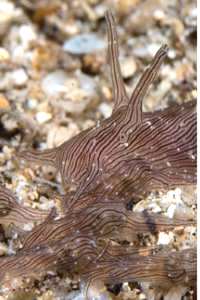
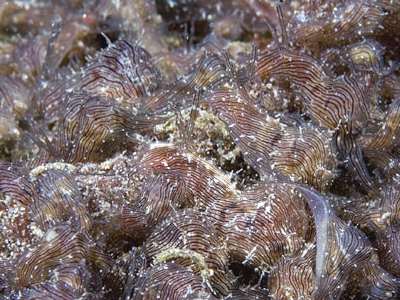
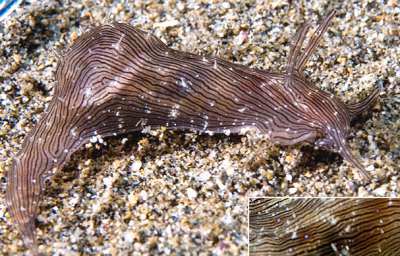
Dear Mike,
Thanks for another record of this fascinating behaviour. We have two earlier records on the Forum of this mass swarming of Stylocheilus in Hawaii [Cory Pittman - #424; John Hoover - #6681]. Have a look at my comments on this phenomenon attached to those messages, and the mass mortality Fact Sheet, where I discuss the mass swarming behaviour found in many Sea Hares. We can't really say why there are so many together like this, so using terms like migration and even aggregation or swarming suggest things which we are not sure about. I tend to think these animals settle out of the plankton and grow close to where they settle only becoming noticeable when the oldest cohort in the population reach adulthood. Perhaps a clue is their food. They feed on a brownish layer of blue-green algae or more properly cyanobacteria. If you look at your upper photo you will see a brownish stain across the sand which is what they are feeding on. I suspect environmental conditions may cause the cyanobacteria to be arranged unevenly on the sand and the 'rows' or 'streams' of Stylocheilus may reflect the distribution of the brown 'stain' they feed on. Whether they are actually 'going anywhere' - like in a spiny lobster migration - is most doubtful.
What makes your record particularly interesting is the observation of the two predators, a species of puffer fish, and the cephalaspidean sea slug Philinopsis cyanea . I have put your photos of Philinopsis in a separate message #14082. Your message on Digitaldiver.net also generated another interesting record of mass swarming in Stylocheilus striatus from the Caribbean [see message #14080]. Any time you witness nudibranchs and related sea slugs 'doing things' like this - think of us obsessive students of sea slugs - such messages are always welcome.
Best wishes,
Bill Rudman
Stylocheilus swarmimg in the Caribbean
June 20, 2005
From: Jim Chambers
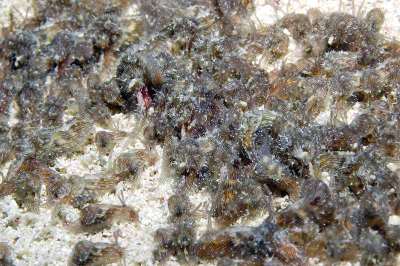
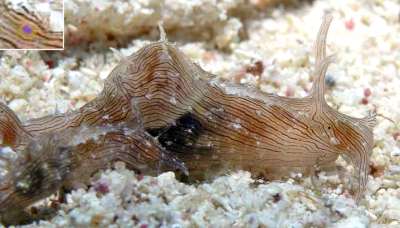
Howdy Bill,
Thanks for your interest! Our message in Digitaldiver.net was in response to Mike Roberts' message concerning the mass swarming of Stylocheilus striatus in Hawaii [message #14074]. We observed a similar phenomenon recently in the Caribbean.
My wife/dive buddy Deborah and I saw the sea hares on Friday, May 20 (the full moon was on the 23rd, so it probably was not Lunar-related). We were on the north side of Little Cayman Island (about 90 miles ENE of Grand Cayman) at the site of an old shipwreck, the Soto Trader. The surrounding bottom is mostly patch corals and featureless sand. Depth was about 40 feet, and there was no current. Water temperature was 80 F (27 C). We noticed what at first appeared to be some clumps of algae moving along the bottom (a common sight), but on closer inspection, we saw that the "algae" was actually at least three separate groups of Blue-Ring Sea Hares [Stylocheilus striatus] (actually we didn't know what they were until we got back on shore and looked them up in our book, since we had never seen a sea hare before). Each group was about the size of a large dinner plate, and there were a lot of "trailers" behind each main group. The largest sea hares were about 4-5 cm (stretched out), and there were many smaller ones about 2-2.5 cm. My best guess is that each group had at least 200-300 sea hares, and they were moving perhaps one foot per minute (rough guess) away from shore. Unfortunately, we were running low on air, so we didn't have a chance to investigate further.
The next day, we met Judie Clee with R.E.E.F. She was staying on Little Cayman, and the divemaster had mentioned what we had seen to her, so she came by to talk with us and see our photos (Deborah also has a short video clip of the sea hares). After Judie returned home to Bermuda, she forwarded the information to at least one marine biologist. So far, no one seems to have any idea what the migration was about, so it appears to be a real mystery waiting to be solved. I have attached my photos. Please feel free to use any of this information and photos however you like. If it helps to solve the mystery, that would be great.
Deborah and I are already planning to return to Little Cayman the same time next May in the hope of seeing this again. It's a long shot, but we love Little Cayman and we'd return for a lot less reason than that!
Thanks again for your interest!
Jim Chambers
jimbo_limited@mindspring.com
Chambers, J., 2005 (Jun 20) Stylocheilus swarmimg in the Caribbean. [Message in] Sea Slug Forum. Australian Museum, Sydney. Available from http://www.seaslugforum.net/find/14080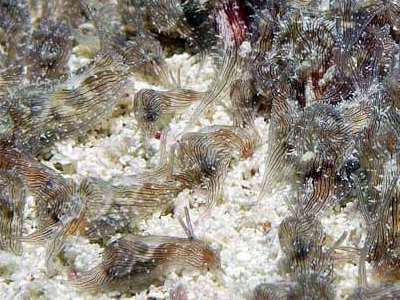
Dear Jim,
It's certainly interesting to have the same phenomenon reported from two oceans at much the same time. Have a look at my comments to Mike Robert's message [#14074] about what we know about it. I've added an inset on one of your photos to show the little blue rings which are sometimes found on this species.
Best wishes,
Bill Rudman
White Hawaiian Pleurobranch?
April 15, 2005
From: Keoki Stender
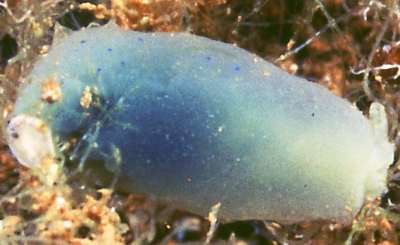
Hi Bill,
Here's a tiny white slug from a tidepool on the SW tip of Lana'i, Hawaii. Is this Berthella stellata?
Locality: Kaunolu Bay tidepool, SW tip of Lana'i Island, Hawaii, USA. Depth: 0.5 m. Length: 7 mm. 23 March 2003. shallow tidepool with sparse algal turf, boulders, and red silt. Photographer: Keoki Stender
Thanks,
Keoki Stender
www.coralreefnetwork.com/stender
fishpicshi@yahoo.com
Stender, K, 2005 (Apr 15) White Hawaiian Pleurobranch?. [Message in] Sea Slug Forum. Australian Museum, Sydney. Available from http://www.seaslugforum.net/find/13464
Dear Keoki,
The blue spots on this animal, which seem to have a ligher ring around each spot, look very like the blue 'eye spots' found in some Sea Hares, such as Stylocheilus striatus and Bursatella leachii. I think you photos show a juvenile S. striatus lying on its side, with us looking at the sole of its foot. At the right end of the photo is what I think is the head, the enrolled tentacle you can see, rather than being the enrolled rhinophore of a pleurobranch is the oral tentacle of a Sea Hare. I don't know any pleurobranch with blue spots like this, and B. stellata usually has some sign of an opaque white cross on the mantle. The absence of dark lines sometimes occurs in juveniles, but the fact that it lying on its side suggests it is dead or dying and so some of the outer colouration may have gone.
Of course I may be quite wrong - its a bit hard with a photo. If I had a specimen I could roll it over or give it a gentle poke and prod.
Best wishes,
Bill Rudman
Stylocheilus striatus from Brazil
February 16, 2005
From: Vinicius Padula

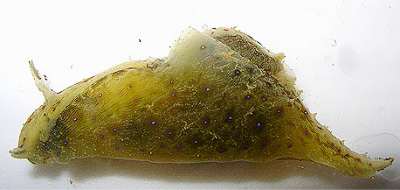
Dear Bill,
Here is another opisthobranch from Recife in Brazil. I don't know if this animal with blue spots is a juvenile of Bursatella leachii [see my earlier message #13150] or is another species.
They both occur in the same mangrove connected to the sea.
Locality: Mangrove, Pernambuco, Recife, Brazil. Depth: 1 m. Length: 35 mm. 5 February 2005. In sediment. Photographer: Vinicius Padula
Best Regards,
Vinicius Padula
viniciuspadula@hotmail.com
Padula, V., 2005 (Feb 16) Stylocheilus striatus from Brazil. [Message in] Sea Slug Forum. Australian Museum, Sydney. Available from http://www.seaslugforum.net/find/13129Dear Padula,
This is Stylocheilus striatus. This species often occurs with Bursatella leachii all around the world, although Stylocheilus is also found in more open water and reefs, while Bursatella is usually found in quieter waters, such as mangroves, coastal ponds and sheltered silty bays.
Best wishes,
Bill Rudman
Stylocheilus striatus or S. striata ?
January 5, 2005
From: Marina Poddubetskaia

Dear Bill,
This species is referred to both Stylocheilus striatus and Stylocheilus striata. What is the right name? I can see that you call it S. striatus, but why some specialists call it S. striata?
Locality: 'Napaling', Panglao Island, Philippines, Pacific Ocean. Depth: 2-20 m. Length: 13 mm. 07 June 2004. on algae. Photos: Marina Poddubetskaia - Nembro website
Thank you in advance for your help.
Best wishes,
Marina.
nembro@nembro.info
Poddubetskaia, , 2005 (Jan 5) Stylocheilus striatus or S. striata ?. [Message in] Sea Slug Forum. Australian Museum, Sydney. Available from http://www.seaslugforum.net/find/12903Dear Marina,
Scientific names are either from Latin or latinised Ancient Greek, OR are words from modern languages which have been Latinised. When the first set of International Rules for zoological names was written, the committee, in its wisdom, decided that in species names, the species word [striatus] should match the gender of the genus word [Stylocheilus]. This means that if a species changes genus, as they often do, then often the ending of the species names has to change to match the gender of the new genus name. This rule still applies, although many taxonomists feel that in the age of databases and electronic searches, changing word endings like this is an unnecessary complication, especially when so few of us now have any idea what the correct gender endings are in Latin.
Richard Willan, in an earlier message [#2517] discussed the striata versus striatus question:
"Unfortunately I think you need to change your name once again. Quoy & Gaimard originally used the name Aplysia striata. But the gender of Stylocheilus is masculine, so the specific name striatus, -a, -um , which is a Latin adjective meaning striped or lined, needs to be written in the masculine form, striatus, to be in agreement with the genus".
Best wishes,
Bill Rudman
Stylocheilus striatus from Jamaica
October 21, 2003
From: Ross W. Gundersen
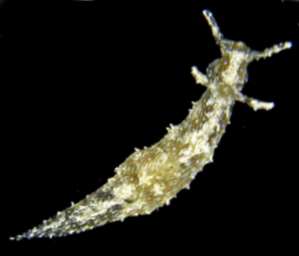
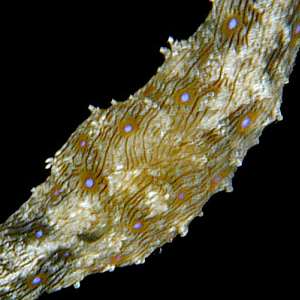
Dear Bill:
Here is another sea slug from Jamaica. As I said in my first message, all specimens were collected from St. Ann's Bay, Jamaica, West Indies. Most specimens were collected using a light weight dredge and photographed by R. Gundersen.
Here is Stylocheilus striatus. Dredged at 5m in Thallassia.
Blue spots are extremely variable in intensity. In some individuals they are very faint blue. Typical striations of darker brown on tan field.
Best wishes,
Ross
ross.gundersen@uwp.edu
Gundersen, R.W., 2003 (Oct 21) Stylocheilus striatus from Jamaica. [Message in] Sea Slug Forum. Australian Museum, Sydney. Available from http://www.seaslugforum.net/find/11134Thanks Ross,
Bill Rudman
Re: Stylocheilus striatus (?) from Grenada
August 23, 2003
From: Marli Wakeling
Hi Bill,
Thanks for your comment. Stylocheilus striatus was my initial thought, until I got the slide back. What doesn't appear in the scan are the bright blue dots on the bodies. Does that help?
Marli Wakeling
scubamarli@excite.com
Wakeling, M., 2003 (Aug 23) Re: Stylocheilus striatus (?) from Grenada. [Message in] Sea Slug Forum. Australian Museum, Sydney. Available from http://www.seaslugforum.net/find/10821Dear Marli,
Blue spots, usually called 'ocelli' or 'eye spots' because they have a dark ring around them, are found in quite a dfew sea hares [Stylocheilus, Bursatella, Notarchus]. In earlier messages you'll see that Stylocheilus striatus from both Florida and Lord Howe Island, off the east coast of Australia, have these blue spots.
Best wishes
Bill Rudman
Stylocheilus striatus from Grenada
August 22, 2003
From: Marli Wakeling
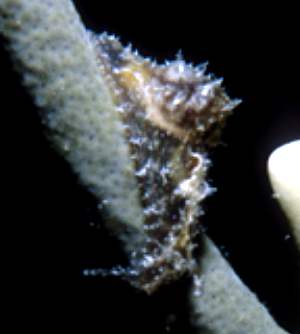
Hi Bill,
We found lots of these sea hares on night dives on Ronde Island, Grenada, Caribbean. I think they are Stylocheilus longicauda.
Date: July, 2003
Location: Ronde Island, Grenada
Depth: 30 feet
Length: 1.5 cm.
Photo: Marli Wakeling
Cheers,
Marli
scubamarli@excite.com
Wakeling, M., 2003 (Aug 22) Stylocheilus striatus from Grenada. [Message in] Sea Slug Forum. Australian Museum, Sydney. Available from http://www.seaslugforum.net/find/10794Dear Marli,
It's a bit hard to be sure from this photo but it seems to be Stylocheilus striatus
Best wishes,
Bill Rudman
Sea hares & Lyngbya majuscula
May 24, 2003
From: Steve Arquitt
Hello,
I am currently working on a dynamic model of Lyngbya majuscula bloom. I have read that the sea hare is an important grazer of Lyngbya. I would be very interested in any work or information on the dynamic interaction between Lyngbya majuscula and the sea hare.
Thank you.
Steve Arquitt
Centre for Marine Studies
Univ. of Queensland
sarquitt@mailbox.uq.edu.au
Dear Steve,
There are many species of Sea Hares, two of which feed on Lyngbya majuscula. If you look at the Fact Sheets for Stylocheilus striatus and Burstaella leachii you will find information on the two relevant species. There are also links to relevant reference pages. Scroll down each page to find more information in the accompanying messages. If necessary you could also use the Forum SEARCH engine and look for links to lyngbya
Good luck,
Bill Rudman
Stylocheilus striatus from Lord Howe Island
January 27, 2003
From: W.B. Rudman

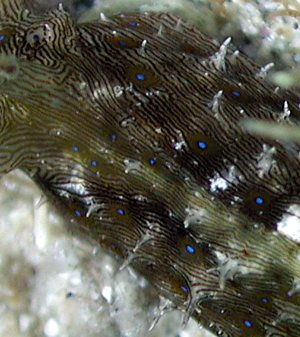
Here is a photo record from Ian Hutton of Stylocheilus striatus from Lord Howe Island.
Location: Neds Beach.
Bill Rudman
Rudman, W.B., 2003 (Jan 27) Stylocheilus striatus from Lord Howe Island. [Message in] Sea Slug Forum. Australian Museum, Sydney. Available from http://www.seaslugforum.net/find/8986Stylocheilus striatus from Sulawesi
January 8, 2003
From: Mary Jane Adams
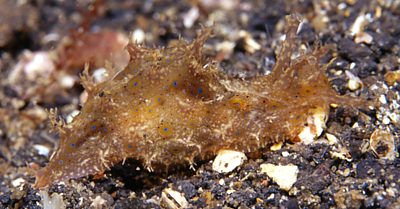
Hi Bill,
Because of the bright blue spots I identified this sea hare as Stylocheilus striatus. However, there are only a few faint striations.
I photographed it shortly after dark in Lembeh Strait, Sulawesi Island, Indonesia on Nov. 22, 2002. Divesite: Tekat Larry, Length: 20 mm, Depth: about 10 meters.
Best regards,
Mary Jane
divepng@yahoo.com
Adams, MJ., 2003 (Jan 8) Stylocheilus striatus from Sulawesi. [Message in] Sea Slug Forum. Australian Museum, Sydney. Available from http://www.seaslugforum.net/find/8714Dear Mary Jane,
It is sometimes difficult to be sure from a single photo. In some ways this looks like a scyllaeid. I can't see the rhinophores clearly enough or determine the nature of the 'parapodial' region. It does however look quite like Stuart Hutchison's photo of Stylocheilus from Indonesia, but that animal was definitely lined.
Cheers,
Bill Rudman
Stylocheilus striatus from Florida
October 22, 2002
From: Linda Ianniello
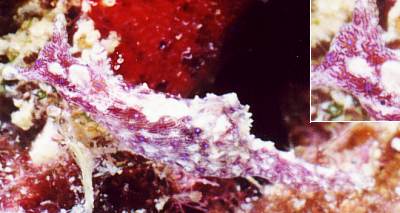
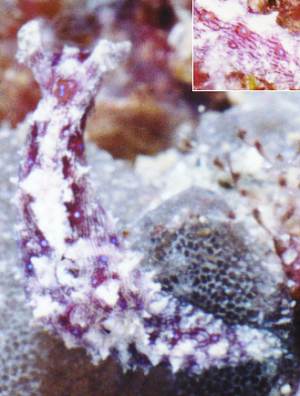
Dr. Bill,
Here is one from Florida that I can't identify with my literature. Sorry, the pictures are not very good. It was about 1/2" long and I had the wrong size framer. It was found off Delray Beach in October, 2002, at a depth of about 15', during the day. I am hoping that the color might be a clue, as it is quite unique.
Thanks for you help!
Linda Ianniello
lindai@us.ibm.com
Ianniello, L., 2002 (Oct 22) Stylocheilus striatus from Florida. [Message in] Sea Slug Forum. Australian Museum, Sydney. Available from http://www.seaslugforum.net/find/8211Dear Linda,
This is the ubiquitous Stylocheilus striatus, which was previously known as Stylocheilus longicauda. I have shown the characteristic lines and blue 'eyespots' in insets on your photos. This animal is a bit browner in background colour than I am used to in the Pacific, but otherwise seems very similar in colour. There are many records of this small Sea Hare from the Caribbean, but I suspect it is often overlooked because it is so well camouflaged.
Best wishes,
Bill Rudman
Ink Gland in Stylocheilus striatus
September 3, 2002
From: Angela Capper
Dear All
Just a quick note to ask if anyone knows of a detailed drawing of Stylocheilus striatus which shows the location of the ink gland.
Thanks
Angela Capper
angelacapper@hotmail.com
Capper, A., 2002 (Sep 3) Ink Gland in Stylocheilus striatus. [Message in] Sea Slug Forum. Australian Museum, Sydney. Available from http://www.seaslugforum.net/find/7872
Dear Angela,
As luck would have it I am preparing some anatomical diagrams at present so I can help you out. Sea Hares have two major glands in the mantle cavity. One on the roof of the mantle cavity usually secretes a red wine or purple coloured 'ink' so is often called the Purple Gland, and the second is on the floor of the cavity and secretes a thick white fluid. It is known as the Opaline Gland. In Sea Hares, such as Stylocheilus, in which the shell is lost, the 'roof' of the mantle cavity, which used to enclose the shell, is also absent, except for a small ridge on the inside of the left parapodia. The Purple Gland in Stylocheius opens on the underside of the anterior end of this ridge (purple patches in my diagram). I have marked the position of the Opaline Gland in brown.
I hope this solves your problem. I would be interested in knowing a little about your research,
Best wishes,
Bill Rudman
Early larvae of Stylocheilus striatus
May 25, 2002
From: Duncan Revell
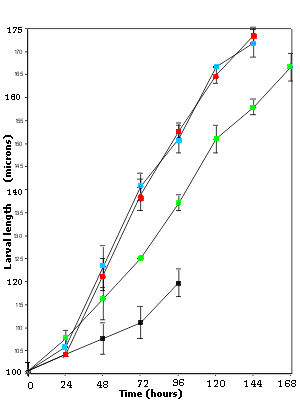
Bill,
I sent you a message back in February when I started my 4th year Aquaculture hons project on Stylocheilus striatus larvae at the Bribie Island Aquaculture Research Centre, near Brisbane [Queensland, Australia]. I'm now back in Stirling University, Scotland, having handed in my thesis a week ago. I found that of the microalgae I fed them, Nannochloropsis oculata gave the highest survival rates of the newly hatched S. striatus veligers. However, Tetraselmis chuii gave the highest growth rates over an 8 day period. Both freshwater and 20ppm of formalin were extremely toxic to the veligers, and the adult fecundities were around 1,200,000 larvae/Kg of sea hare. Here are some of the graphs from my thesis. I found rearing the larvae through to settlement very difficult, and as I was running out of time I decided just to experiment on the newly hatched larvae.
Thank you for your identification help.
UPPER RIGHT: Food type and Growth of Stylocheilus striatus Larvae. Blue = Isochrysis galbana-fed larvae; Green = Nannochloropsis oculata-fed larvae; Red = Tetraselmis chuii-fed larvae; Black= Unfed larvae.
LOWER LEFT: Number of Larvae produced by 18 individual Stylocheilus striatus in relation to weight.
LOWER RIGHT: The Survival rates of Stylocheilus striatus Larvae. Fed Isochrysis galbana [Blue]; Fed Nannochloropsis oculata [Green]; Fed Tetraselmis chuii [Red]; Unfed larvae [Black].
Duncan Revell.
duncan_revell@hotmail.com


Dear Duncan,
Thanks for keeping in touch and letting us know how things went.
Best wishes,
Bill Rudman
Feeding in Stylocheilus longicauda
May 14, 2002
From: Jan Drexel
Dear Bill,
My name is Jan, I'm a student from the University of Heidelberg. At the moment I seek for information about seaslugs off the coast of Queensland. If I am right in the waters of Stradbroke Island (near Brisbane) there occurs a sea hare Stylocheilus longicaudatus feeding also on the cyanoalga Lyngbya majuscula. Have you ever heard about the whole feeding habits of that snail? Is it much discriminative and therefore reduced to that species does it also feed on other algae? I'd be happy if you could help me in that point.
Regards,
Jan
jandrexel@hotmail.com
Drexel, J., 2002 (May 14) Feeding in Stylocheilus longicauda. [Message in] Sea Slug Forum. Australian Museum, Sydney. Available from http://www.seaslugforum.net/find/6948Dear Jan,
Firstly the animal you are interested in used to be identified as Stylocheilus longicauda but is now know as Stylocheilus striatus. From all accounts it seems to be a specific feeder on Lyngbya. Have a look at the Fact Sheet on this species for the information you require. There is a link there to a page of Stylocheilus references, including a number on feeding. Also look at the earlier correspondence on this species.
Best wishes,
Bill Rudman
Stylocheilus striatus from Balai
March 25, 2002
From: Stuart Hutchison
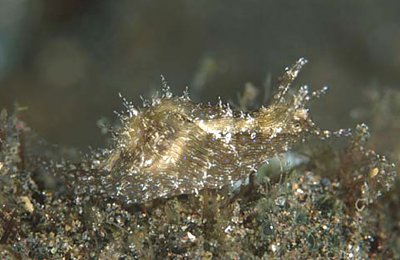
Hi Bill,
Here's Stylocheilus striatus from Bali, Indonesia on 24 Oct 2001. Length 30mm. Depth 10m.
Regards,
Stuart
stuart@stuarthutchison.com.au
Hutchison, S., 2002 (Mar 25) Stylocheilus striatus from Balai. [Message in] Sea Slug Forum. Australian Museum, Sydney. Available from http://www.seaslugforum.net/find/6303Thanks Stuart,
Bill Rudman
Stylocheilus striatus - veliger larvae
February 18, 2002
From: Duncan Revell
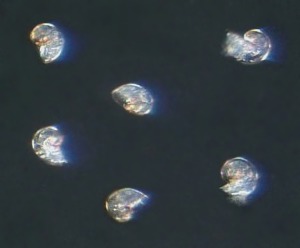
Thanks Bill for the info and references on Stylocheilus striatus. I've attached a digital photo I took of a 2 day old veliger, about 100 microns long. I'll keep in touch with any interesting findings.
Thanks again,
Duncan.
duncan_revell@hotmail.com
Revell, D., 2002 (Feb 18) Stylocheilus striatus - veliger larvae. [Message in] Sea Slug Forum. Australian Museum, Sydney. Available from http://www.seaslugforum.net/find/6293Thanks Duncan,
It would certainly be nice to have an illustrated life history of Stylocheilus when you get organised
Best wishes,
Bill Rudman
Stylocheilus striatus - life history studies
February 13, 2002
From: Duncan Revell
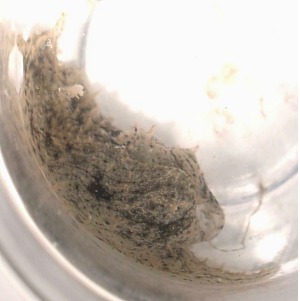
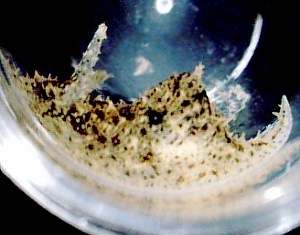
Hello Bill.
I'm a 4th year aquaculture honours student from Stirling University, Scotland, and I'm currently over here at the Bribie Island Research Centre, nr. Brisbane [Queensland, Australia] starting my honours project. My project is on larval rearing of the sea hare Stylocheilus striatus, although I am not 100% sure this is the correct ID of the species. I've collected several sea hares from one of the salt water ponds here. Most are about 3-4cm long, green/brown in colour with small spikes all over its body. There are also dark spots with thin stripes along the body. The eggs are white/yellow and then turn brown/red soon before hatching. The shelled veligers are very small, maybe 30 microns.
I was wondering whether you could identify the species for me through these photos I've attached. I was wondering also how long it takes for the eggs to hatch, whether they breed all year round, whether they can self fertilise themselves, and how long it takes from hatching to settlement of the larvae.
I realise not a great deal is known about sea hares, but from your website you seem to be extremely knowledgable about these animals. I would be extremely grateful if you could answer some of my questions.
Thanks Bill,
Duncan.
duncan_revell@hotmail.com
Revell, D., 2002 (Feb 13) Stylocheilus striatus - life history studies. [Message in] Sea Slug Forum. Australian Museum, Sydney. Available from http://www.seaslugforum.net/find/6192Dear Duncan,
I can definitely say that your animals are Stylocheilus striatus and I know of no evidence to show that any opisthobranch, even with their hermaphrodite reproductive system, is able to self-fertilise. There have been studies in Hawaii on Stylocheilus striatus (as S. longicuada) See if you can get hold of copies of the two Switzer-Dunlap references on the Stylocheilus references Page. There is also an aquarium stockist who sells Stylocheilus under the name 'Sea Bunnies'. From his advertising spiel it seems they are not difficult to breed in aquaria.
Paige (1986, 1988) published results of a similar study on the west Atlantic subspecies of Bursatella leachii, which is very similar in shape and feeding biology to Stylocheilus striatus, so that study would be worth reading. There have also been studies on various species of Aplysia, but many of the points you need to know such as development time, breeding cycles etc are likely to differ from species to species, so you are basically on your own.
• Paige, J.A. (1986) The laboratory culture of two Aplysiids Aplysia brasiliana Rang, 1828 and Bursatella leachi plei (Rang, 1828) (Gastropoda: Opisthobranchia) in artificial seawater. The Veliger, 29(1): 64-69.
• Paige, J.A. (1988). Biology, metamorphosis and postlarval development of Bursatella leachii plei Rang (Gastropoda: Opisthobranchia). Bulletin of Marine Science, 42(1): 65-75.
Good luck with your research,
I look forward to hearing of your progress. If by chance you could share some photos of the egg masses and perhaps veligers, they would be most welcome.
Best wishes,
Bill Rudman
Re: Green Nudibranch
February 24, 2001
From: Timothy Loyd
Thanks for the I.D. One question though; Can this species reach lengths of 10cm or greater? Since I sent the last message I have spotted more nudibranchs. I believe the other species are Elysiella pusilla (flat variety). I have become curious how a nudibranch at any stage of developement could survive 2-3 days on or in a piece of live rock wrapped in wet newspaper. I would be interested in any thoughts you might have on this subject. Thanks Again,
Tim
tim@aquaticconnection.com
Loyd, T., 2001 (Feb 24) Re: Green Nudibranch. [Message in] Sea Slug Forum. Australian Museum, Sydney. Available from http://www.seaslugforum.net/find/3858Dear Tim,
From your reply are you telling me your animal was more than 10cm long? If so, you may have Bursatella leachii, which looks quite like Stylocheilus striatus, but is normally not as elongate as in your photo. However I can't really be sure from your photo. The largest S. striatus I know of are some specimens I collected in Zanzibar. They were about 65mm long. So if your animals are more than 100mm long you either have a new size record for Stylocheilus striatus or you have something else.
Concerning your other slugs. I guess its possible you have Elysiella pusilla but that species seems to be restricted to the jointed calcareous alga Halimeda. Have you that growing on your 'live rock'. Otherwise you may have a species of Elysia. How do they survive the trials of being transported halhway around the world on a rock wrapped in damp newspaper. I suppose I could make a joke about the quality of the articles in the paper, but I will restrain myself. Very small slugs, and other marine invertebrates for that matter, can survive for some time out of water, as long as they are kept damp. If they remain moist they are still able to breathe through their skin at least for a few days, and they are probbaly protected from crushing by being in a small hole or crevice in the rock. As long as there is some appropriate food on the rock once they are unwrapped and placed in an aquarium, they will recover and grow quite quickly. I would suspect that the animals you are seeing now almost certainly arrived on your rock as small juveniles.
Best wishes,
Bill Rudman
Anatomy of a spotted sea hare
February 22, 2001
From: Brandon
I am writing a term paper on the spotted sea hare for an oceanography course, and I am finding it difficult to find information on this specific species. I would like to have a diagram showing the anatomy of a Sea Hare. In addition, to some references I might be able to use to find information.
Thank you!
Brandon
Brand_Smith79@hotmail.com
Smith, B., 2001 (Feb 22) Anatomy of a spotted sea hare. [Message in] Sea Slug Forum. Australian Museum, Sydney. Available from http://www.seaslugforum.net/find/3799Dear Brandon,
The only books I know that might be easily available to you are Kandel's which you will find references to on the Sea Hares page. i thik the earlier one of the two has a series of diagrams showing the anatomy of different Sea Hares.
One problem I have is knowing what you mean by the Spotted Sea Hare. Common names are not usually used by biologists so I ma afraid I ma not sure which species you are referring to. Two possibilities are Stylocheilus striatus and Bursatella leachii. If you click on either of those names it will take you to the relevant pages where you will find links to further references. Also scroll down each page and read the attached messages for they have a lot of general information on these animals.
Best wishes,
Bill Rudman
Green Nudibranch
February 21, 2001
From: Timothy Loyd
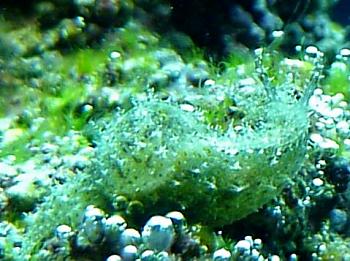
Hello-
I am trying to identify some nudibranchs. I know that they had to have come in on some live rock from Western Samoa and that they feed on hair algae and possibly other types of algae. In the attached picture it is hard to make out the form of the nudibranch, but it is the best I could get. Any information would be appreciated.
Tim
loyd1123@aol.com
Loyd, T., 2001 (Feb 21) Green Nudibranch. [Message in] Sea Slug Forum. Australian Museum, Sydney. Available from http://www.seaslugforum.net/find/3795Dear Tim,
I am pretty sure you have Stylocheilus striatus in your tank. Have a look at the information above and below your message. It should give you plenty of information about this common small Sea Hare. They shouldn't cause any problems in your aquarium and could in fact be quite useful in keeping algal films from growing on the glass and other surfaces.
Best wishes,
Bill Rudman
Sea Bunnies- Florida?
December 15, 2000
From: John E. Billings
Hello all,
I am starting a marine aquarium, hoping to have local creatures mostly. I saw on your site that Stylocheilus striatus, which is sold by IPSF as a Sea Bunny, is distributed widely in the tropics. Can it, or a similar species, be found on the Florida coast?
Thanks much,
John Billings
rev320@bellsouth.net
Billings, J.E., 2000 (Dec 15) Sea Bunnies- Florida?. [Message in] Sea Slug Forum. Australian Museum, Sydney. Available from http://www.seaslugforum.net/find/3355Dear John,
It is certainly found in the Caribbean, and has been recorded (as Stylocheilus longicauda) from Miami. If it's around it normally occurs in quite large numbers.
Good Luck with your aquarium,
Bill Rudman.
Microcoleus & Lyngbya
October 24, 2000
From: Clay Carlson
Bill,
I think what you said about Lyngbya and Microcoleus is reversed. Microcoleus is the older term. It has apparently turned out that there were a number of species lumped as M. lyngbyaceus. One of these is now called Lyngbya majuscula.
When I asked Dr. Roy Tsuda what was going on, this is the answer I got.
"Lyngbya majuscula (Dillwyn) Harvey is just one of the 100's of species which Dr. Francis Drouet lumped under Microcoleus lyngbyaceus. Lyngbya majuscula is the large blue-green (green, black or red in color) which can be found in shady areas, e.g., under coral ledges on the reef flat, or on the sandy bottom of the murky Cocos Lagoon. It is unique; however, it can be difficult to differentiate from a few other Lyngbya."
If you notice in your list of references, the earlier names are Microcoleus, the last 1998 article uses Lyngbya. Since some of these forms co-exist, this could explain why we have what we thought was so many of the haminoeid forms feeding on the same algae/bacteria.
Clay
clay.carlson@kuentos.guam.net
Carlson, C., 2000 (Oct 24) Microcoleus & Lyngbya. [Message in] Sea Slug Forum. Australian Museum, Sydney. Available from http://www.seaslugforum.net/find/3235Dear Clay,
Thanks for correcting me. I must admit I was puzzled by the date anomaly in the reference list but had been following Richard Willan's earlier message on Bursatella leachi.
Best wishes,
Bill Rudman.
Stylocheilus striatus and secondary metabolites
October 22, 2000
From: Lloyd Godson
Do you have any information on current research looking at whether the sea hare Stylocheilus longicauda contains any of the toxins found in Lyngbya majuscula?
Lloyd Godson
nosdog@hotmail.com
Godson, L., 2000 (Oct 22) Stylocheilus striatus and secondary metabolites. [Message in] Sea Slug Forum. Australian Museum, Sydney. Available from http://www.seaslugforum.net/find/3205Dear Lloyd,
There are a couple of name problems you should be aware of.
Firstly, the animal that has usually been called Stylocheilus longicauda should be called Stylocheilus striatus. There is a page explaining why if you are interested.
The second name problem concerns its food. Although long been considered a blue-green algae Lyngbya majuscula, the 'plant' group it belongs to is now considered to be a group of cyano-bacteria, outside the Plant Kingdom. Some authors therefore have changed its name to Microcoleus lynbyaceus. So you will need to search both names. I am not sure if you have looked through the Forum but there is a page of relevant references. I have added a couple of relatively new references quite recently.
If you would like to give us some details of your research interest I am sure there will be visitors to the Forum who would be interested.
Best wishes,
Bill Rudman.
Note added Oct 23, 2000: I got this reversed - Microcoleus is earliest name. See Clay Carlson's message.
Rudman, W.B., 2000 (Oct 22). Comment on Stylocheilus striatus and secondary metabolites by Lloyd Godson. [Message in] Sea Slug Forum. Australian Museum, Sydney. Available from http://www.seaslugforum.net/find/3205Which sea hare is this one?
September 29, 2000
From: Phanor Montoya
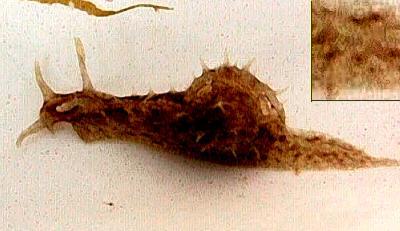
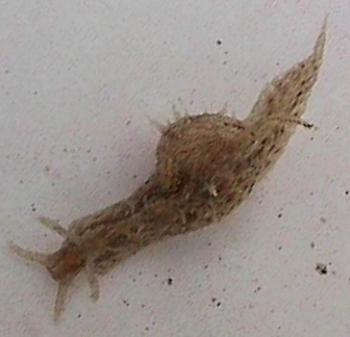
This Sea Hare was found on a soft bottom cover with Halodule sp and Syringodium sp seagrasses. I found a big population of these small animals (1-3cm,) and they were together with big Bursatella leachii plei. I don't thinks this sea hare is a juvenile Bursatella, what do you think?
Thanks,
Phanor
phamont@eudoramail.com
Montoya, P., 2000 (Sep 29) Which sea hare is this one?. [Message in] Sea Slug Forum. Australian Museum, Sydney. Available from http://www.seaslugforum.net/find/3087Dear Phanor,
I guess your animals are from Santa Marta, Colombia?
You are quite right in thinking they are not juvenile Bursatella. They are Stylocheilus striatus which has a circumtropical distribution. It is often found with Bursatella, probably because both feed on a layer whch we use to call blue-green algae but are now considered to be cyanobacteria. Throughout its range Stylocheilus striatus ranges in colour pattern from a blotchy unlined form, as in your upper photo, to a characteristic lined form which is well-illustrated in recent message. Your lower photo is of an inetrmediate colour form with elongate brown marks rather then lines. In the inset in the upper photo you can see the 'eyepots' which are often found in both this species and Bursatella. They can have a blue, black, or even pink centre and an orange or green-blue ring.
There are quite a few records of this animal from the Caribbean and the tropical west Atlantic and I have listed a few of them below. In all cases it has been misidentified as Stylocheilus longicauda.
• Clark, K.B., (1984) New records and synonymies of Bermuda opisthobranchs (Gastropoda). The Nautilus 98(2): 85-97.
• Marcus, Ev. & Hughes, H.P.I., (1974) Opisthobranch mollusks from Barbados. Bull. Mar. Sci., 24(3): 498-532.
• Marcus, Ev & Marcus, Er, (1963) Opisthobranchs from the Lesser Antilles. Studies on the Fauna of Curacao and other Caribbean Islands 19(79): 1-76.
• Marcus, Ev, (1972) On the Anaspidea (Gastropoda: Opisthobranchia) of the warm waters of the western Atlantic. Bull. Mar. Sci., 22(4): 841-874.
• Thompson, T.E., (1977): Jamaican opisthobranch molluscs I. Journal of Molluscan Studies, 43(2): 93-139.
Best wishes,
Bill Rudman.
Stylocheilus from the Caribbean
September 27, 2000
From: Barry Lipman
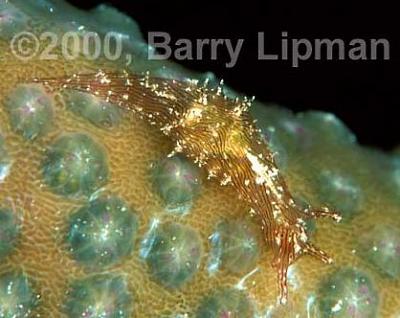
Hi,
This is one of two critters I found on a very popular dive site on Grand Cayman last week [September 2000]. The depth was about 50 feet. Both were found at night on the same dive, on coral or on a sponge, where the sand meets the reef. They are very small, 1/2 to 3/8 inch or so.
I am, as always, very curious. I appreciate your help in this matter, and if I can return the favor in any way, let me know.
I am a pro-photographer specializing in marine life and travel photography. My website is at http://www.barrylipman.com.
Barry Lipman
b_lipman@hotmail.com
Lipman, B., 2000 (Sep 27) Stylocheilus from the Caribbean. [Message in] Sea Slug Forum. Australian Museum, Sydney. Available from http://www.seaslugforum.net/find/3075Dear Barry,
This animal is a small Sea Hare called Stylocheilus striatus. It has a circumtropical distribution, being found in both the Caribbean and the Indo-West Pacific. Any other Caribbean Sea Slugs you photograph would be very welcome on the Forum.
Best wishes,
Bill Rudman.
Re: Another aquaria slug-type creature
June 8, 2000
From: Michelle Catalano
Thanks Bill :).
My best guess is that it's the D. dolabrifera. Haven't seen it again since I took the blurry pictures though, so I can't swear to it. Hopefully it will show back up again when I've learned more about my camera!
I just wanted to say thanks for providing this resource. It's a wonderful site to wander through, and your knowledge is impressive!
Cheers!
Michelle Catalano
michelle@albany.net
Catalano, M., 2000 (Jun 8) Re: Another aquaria slug-type creature. [Message in] Sea Slug Forum. Australian Museum, Sydney. Available from http://www.seaslugforum.net/find/2529Another aquaria slug-type creature
June 7, 2000
From: Michelle Catalano
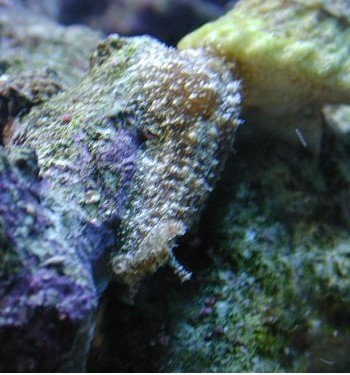
Hi - Just saw this for the first time in a reef tank with Fiji and Monono live rock that has been set up since May 17. It's approximately 5cm long, give or take since it expands and contracts.I've seen no evidence of frilly gill structures on it's butt, just the 2 sets of antenna like things on it's front end.
Anyone have an idea what it is and whether or not it's harmful?
Thanks,
Michelle Catalano
michelle@albany.net
Catalano, M., 2000 (Jun 7) Another aquaria slug-type creature. [Message in] Sea Slug Forum. Australian Museum, Sydney. Available from http://www.seaslugforum.net/find/2506Dear Michelle,
This is a Sea Hare but I am not sure from the photo which species you have. It is either Dolabrifera dolabrifera or Stylocheilus striatus.
If you have a look at the photos and descriptions on those two pages you should be able to identify it yourself. Dolabrifera dolabrifera has quite a wide foot and often moves by stretching its neck forward a bit like a leech. It is also much more muscular and rigid than the soft floppy feel of Styocheilus.
Neither of these herbivorous species will be a problem in your aquarium and on the contrary could be a help, cleaning off the algal film that grows on the glass.
Best wishes,
Bill Rudman.
Aplysiid from Coffs Harbour, NSW
April 28, 2000
From: Carol Buchanan
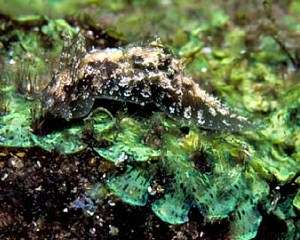
Hi Bill
Can you identify theis aplysiid please? It was taken at South Solitary, [Coffs harbour, nthn New South Wales, Australia] in about 9 metres. It was about 20mm long.
Carol Buchanan
cbimages@turboweb.net.au
Buchanan, C., 2000 (Apr 28) Aplysiid from Coffs Harbour, NSW. [Message in] Sea Slug Forum. Australian Museum, Sydney. Available from http://www.seaslugforum.net/find/2245Dear Carol,
It's a bit hard to make out much detail but I can see a few blue spots amd some dark lines which makes me think this is Stylocheilus striatus [which used to be called S. longicauda]. It could be something else, but I would need another photo to give me some more clues.
Best wishes,
Bill Rudman.
Aplysia sp.? from Papua New Guinea
March 20, 2000
From: Mary Jane Adams
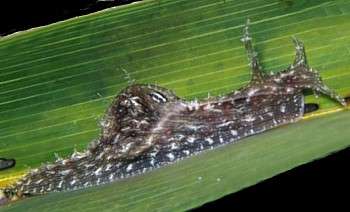
Dear Bill,
Can you identify this sea hare? I found a great number of them at Observation Point, Normanby Island, Papua New Guinea, on March 9, 1998. The divesite is a sand slope with lots of dead leaves and branches. These slugs were concentrated in an area about 3 meters square at a depth of 3-4 meters. Because they were so well camouflaged by the coarse sand, I used a green leaf as a background to show detail in this photo. The only bits of color on them are a few tiny magenta dots scattered over the body. Crawling length was about 40-50 mm. I returned to the same spot two weeks later but, after a thorough search, I could only find one.
Thank you,
Mary Jane Adams
mjadams@earthlink.net
Adams, M.J., 2000 (Mar 20) Aplysia sp.? from Papua New Guinea. [Message in] Sea Slug Forum. Australian Museum, Sydney. Available from http://www.seaslugforum.net/find/2103Dear Mary Jane,
This is Stylocheilus striatus which feeds on the blue-green algal film which is often found on muddy-sand bottoms in sheltered bays. They are often found in large aggregations, perhaps attracted to a patch of blue-green algae.
Best wishes,
Bill Rudman.
Stylocheilus as food
July 23, 1999
From: Bill Rudman
NOMENCLATURAL NOTE: The use of the name Stylocheilus longicauda (Quoy & Gaimard, 1825) in this message is incorrect and the species referred to is really Stylocheilus striatus (Quoy & Gaimard, 1832). See my message and the separate page where the correct identity of these species is discussed. (Added 5 August 1999)
While looking at a reference on Dolabella auricularia I came across this information on Stylocheilus longicauda.
'Stylocheilus longicauda occasionally form large swarms (Switzer-Dunlap & Hadfield, 1979, Pennings & Paul, pers observ.): islanders on Rimatara, Rurutu (Austral Islands), Rarotonga and Mangaia (Cook Islands) collect and and eat S. longicauda from these swarms. Before consumption the islanders 'clean' the S. longicauda by biting off (and eating) the head and then squeezing out and discarding the internal organs: islanders claim that an individual who failed to clean the sea hares this way died after consuming them (G.Paulay & G. McCormak - pers comm). This pattern of predation by humans suggests that the metabolites toxic to humans are located in internal organs.' .. Pennings & Paul (1993)
References:
*Pennings,SC; Paul,VJ (1993): Sequestration of dietary secondary metabolites by three species of sea hares: location, specificity and dynamics. Marine Biology 117, 535-546.
*Switzer-Dunlap,M; Hadfield,MG (1979): Reproductive patterns of Hawaiian Aplysiid gastropods. In: Reproductive Ecology of Marine Invertebrates, Belle W. Baruch Library in Marine Science, number 9. (Ed: Stancyk,SE), 199-210.
Bill Rudman.
Rudman, W.B., 1999 (Jul 23) Stylocheilus as food. [Message in] Sea Slug Forum. Australian Museum, Sydney. Available from http://www.seaslugforum.net/find/1100Breeding & rearing Stylocheilus longicauda
March 11, 1999
From: Gary Henderson
NOMENCLATURAL NOTE: The use of the name Stylocheilus longicauda (Quoy & Gaimard, 1825) in this message is incorrect and the species referred to is really Stylocheilus striatus (Quoy & Gaimard, 1832). See my message and the separate page where the correct identity of these species is discussed. (Added 5 August 1999)
Hi,
I have had 3 adult and one juvenile in a 10 gallon setup for a couple weeks. They seem to be doing quite well. I have quite a bit of macroalgae of various kinds in with them. I have a couple inquiries that would be great if you could give me any insight into. Do you happen to have any references on rearing these guys? I am under the impression that they produce planktonic larvae but am unsure as to how long they remain this way, on what the larvae will feed, any special requirements to help them get to the slug stage, etc. It seems like the sea hares are readily bred and raised in captivity but does this apply to these guys? My other question deals with lighting. I have the lights on 24 hrs a day for algae growth but am curious if this might be bad for the slugs.
Thanks for your time.
Gary Henderson
ghenderson@digiforest.com
Henderson, G., 1999 (Mar 11) Breeding & rearing Stylocheilus longicauda. [Message in] Sea Slug Forum. Australian Museum, Sydney. Available from http://www.seaslugforum.net/find/662Dear Gary,
I have prepared a list of references on Stylocheilus. Two of them by Switzer-Dunlap et al may be useful for you if you can get hold of them.
The life history of Stylocheilus is probably fairly similar to Bursatella leachii and other Sea Hares. It feeds on blue-green algae so the bits of macroalgae in your tank are probably not much use to it, and may in fact be lethal if they start to release toxic chemicals.
If you look through the notes on Sea Hares in the Forum (go to GENERAL TOPICS) you will see they have a diurnal rhythm so they probably aren't very impressed at having their lights on day and night.
Concerning larval development. Keeping veligers alive is not easy. You will see in my earlier message about Stylocheilus, that they were being sold as a source of planktonic larvae for other things to eat. They produce lots of eggs and larvae but getting them past that stage is going to be a labour of love. I've made a few comments on the Larval Culture Page but I'm afraid I have no experience in this field.
Best wishes,
Bill Rudman.
Re: Where do I buy Sea Hares?
February 3, 1999
From: Mark Lanett
NOMENCLATURAL NOTE: The use of the name Stylocheilus longicauda (Quoy & Gaimard, 1825) in this message is incorrect and the species referred to is really Stylocheilus striatus (Quoy & Gaimard, 1832). See my message and the separate page where the correct identity of these species is discussed. (Added 5 August 1999)
Indo-Pacific Sea Farms sells "Sea Bunnies" (Stylocheilus longicauda). http://www.ipsf.com
Mark Lanett
NOTE: I have removed the "sea bunny" image, which appeared here, as IP Sea Farms have asked me not to display it. .... Bill Rudman, 23 March 1999.
Thanks Mark.
I had a look at the site. It's amazing what people buy and sell - and how they are marketed! The picture above is from the Indo-Pacific Sea Farms site and it illustrates their section on Stylocheilus which they have named "Sea Bunnies" - because they breed like rabbits. The Stylocheilus are sold as pairs and if not actually guaranteed to do so - the impression is given that they will be "at it" as soon as you put them in the tank. This is not to provide the aquarium keeper with a vicarious thrill, but to produce millions of eggs which will become larvae and feed all the plankton eating animals in your aquarium
..... and if you were hesitating to order, they are: "Shipped in a plain brown box".
.... and if you don't believe me, have a look at the site yourself at http://www.ipsf.com
Bill Rudman.
